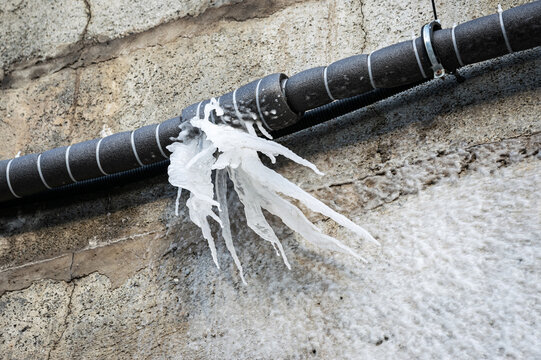We have unearthed this article pertaining to 6 Ways to Prevent Frozen Pipes listed below on the net and figured it made perfect sense to discuss it with you on this page.

Winter can ruin your pipes, specifically by freezing pipelines. Right here's how to stop it from taking place and what to do if it does.
Introduction
As temperatures decline, the risk of frozen pipes rises, potentially leading to expensive repair services and water damages. Understanding how to avoid icy pipelines is crucial for property owners in chilly climates.
Prevention Tips
Protecting prone pipelines
Cover pipelines in insulation sleeves or utilize heat tape to protect them from freezing temperatures. Focus on pipelines in unheated or outside locations of the home.
Heating methods
Maintain indoor spaces appropriately heated, specifically locations with plumbing. Open cupboard doors to permit warm air to circulate around pipelines under sinks.
Just how to determine frozen pipelines
Seek reduced water flow from faucets, unusual odors or noises from pipes, and noticeable frost on subjected pipes.
Long-Term Solutions
Structural changes
Consider rerouting pipes far from outside wall surfaces or unheated locations. Include additional insulation to attics, basements, and crawl spaces.
Updating insulation
Purchase high-grade insulation for pipelines, attics, and walls. Correct insulation assists maintain consistent temperatures and decreases the danger of icy pipelines.
Safeguarding Outdoor Plumbing
Garden tubes and outside faucets
Separate and drain pipes garden tubes before wintertime. Install frost-proof faucets or cover outdoor faucets with shielded caps.
Comprehending Icy Pipelines
What creates pipelines to freeze?
Pipes freeze when exposed to temperatures listed below 32 ° F (0 ° C) for expanded periods. As water inside the pipes ices up, it increases, taxing the pipe wall surfaces and potentially creating them to burst.
Risks and damages
Icy pipes can cause water system disturbances, property damage, and costly fixings. Ruptured pipes can flood homes and trigger extensive structural damage.
Signs of Frozen Pipes
Determining frozen pipelines early can avoid them from breaking.
What to Do If Your Pipelines Freeze
Immediate activities to take
If you think frozen pipes, keep faucets available to soothe stress as the ice thaws. Make use of a hairdryer or towels taken in hot water to thaw pipelines slowly.
Final thought
Preventing icy pipelines needs aggressive procedures and quick feedbacks. By understanding the causes, signs, and safety nets, homeowners can protect their pipes throughout cold weather.
6 Proven Ways to Prevent Frozen Pipes and Protect Your Home
Disconnect and Drain Garden Hoses
Before winter arrives, start by disconnecting your garden hoses and draining any remaining water. Close the shut-off valves that supply outdoor hose bibs and leave the outdoor faucet open to allow any residual water to drain. For extra protection, consider using faucet covers throughout the colder months. It’s also important to drain water from any sprinkler supply lines following the manufacturer’s directions.
Insulate Exposed Pipes
Insulating your pipes is an effective way to prevent freezing. Pipe insulation is readily available at home improvement stores and is relatively inexpensive. Pay close attention to pipes in unheated areas such as the attic, basement, crawl spaces, or garage. Apply foam insulation generously to create a buffer against the cold. You can also wrap your pipes in heat tape or thermostat-controlled heat cables for added warmth.
Seal Air Leaks
Inspect your home for any cracks or openings that could let in cold air. Seal any holes around the piping in interior or exterior walls, as well as the sill plates where your home rests on its foundation. Additionally, make sure to keep your garage door closed unless you’re entering or exiting. Leaving it open creates a significant air leak that can lead to frozen pipes.
Allow Warm Air Circulation
During cold snaps, it’s essential to allow warm air to circulate evenly throughout your home. Leave interior doors ajar to promote better airflow. Open kitchen and bathroom cabinets to help distribute heat consistently around the rooms. If you have small children or pets, be sure to remove any household chemicals or potentially harmful cleaners from open cabinets for safety.
Let Faucets Drip
A small trickle of water can make a big difference in preventing ice formation inside your pipes. When temperatures drop significantly, start a drip of water from all faucets served by exposed pipes. This continuous flow helps prevent the water from freezing. Additionally, running a few faucets slightly can relieve pressure inside the pipes, reducing the chances of a rupture if the water inside does freeze.
https://choateshvac.com/6-proven-ways-to-prevent-frozen-pipes-and-protect-your-home/

Do you like more info about How to prepare your home plumbing for winter weather? Give feedback below. We'd be pleased to know your views about this blog posting. Hoping to see you back again in the future. Sharing is good. You just don't know, you may very well be doing someone a favor. I thank you for your readership.
Call Today